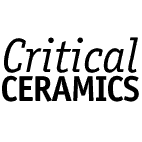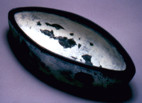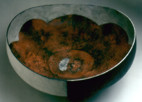Click to find out more...
Show your support by visiting our sponsor...




Untitled (double bowl), 1995


Untitled, 1995


Untitled, 1998
Recently, I spent the better part of a Saturday morning speaking with ceramic artist and Haystack faculty member Steve Heinemann. Mr. Heinemann is one of of the premier Canadian ceramic artists with pieces in major collections including the Longhouse Foundation, New York, the Victoria and Albert Museum, London, the National Museum of History, Taipei, and the Canadian Museum of Civilization, Ottawa. In 1996, he was awarded the prestigious Saiydie Bromfman Award, the highest honor in Canadian craft.
CC: What’s your background? How did you get started?
SH: I’m Canadian. I started working in clay in high school along with all the other two and three dimensional stuff. At that point, I certainly had no confidence in art as a career. However, after high school, I enrolled in Sheridan College which has a good solid crafts department. By my second year, I had decided, “this is it.”
CC: What turned it for you?
SH: Seeing Hans Coper’s work. I had qualms all along about being a functional potter. I knew I liked the medium, but I couldn’t quite see myself working within the restrictions of functional pottery. Coper’s work confirmed, “if clay can do this, yes, I’m in the right place.” After three years at Sheridan, I had had a very good technical focus.
CC: What was next?
SH: I asked around. Kansas City Art Institute kept coming up. Ken Ferguson more or less swept me off my feet. He gave me feedback in five minutes that was as bracing and vital as anything I’d ever had. Ken was my advisor for two years. I also connected with George Timock. In terms of a model of thinking about object making, George’s work was important for me. Here’s a guy who would devote any amount of time to getting what he wanted.
In my time there, I more or less made the transition from wheel thrown work to what I’m doing now - working with molds. All vessels of one sort or another. Although I was meeting with some professional success at that point, since I was in the school mode, I continued. I went to the New York State College of Ceramics at Alfred University for graduate school, although I wasn’t convinced about going to grad school at that point. I came out of there with a different body of work. More massive. Negative spaces. Contained spaces with the sense of imprint. Grad school was the opportunity to take my work to another place.
CC: Since that time, you’ve explored different avenues, but there seems to be a central core...
SH: I’ll follow the work to a certain point, but for some reason, I have a core involvement in this medium that tends to reel me back in. It’s based on a love of the activity for sure - one’s history; the history of one’s decisions. While I’ve constantly brushed up against the edge of another discourse, I’ve found myself cycling around some sort of core involvement in the medium on the one hand and working with the idea of containment on the other.
CC: Would you talk a bit more about interior - the imprint as you described it - versus the positive that’s made that space?
SH: I’m only partially conscious of it. It’s the one commonality in all my work. It haunts the work.
The pattern of reinvention begun at Alfred continues to the present day. I’ve tended to cycle through bodies of work over four or five years. After a time, a completely different one emerges. Thus, over the last fifteen or twenty years there have been four distinct bodies of work. Each one being quite unlike the one that proceeded it. Again, it might seem antithetical to the work that proceeded it, but from another perspective there are threads that continue. While the look may change, the fundamental, preoccupying thread of containment continues throughout. I’m intrigued with the way spaces can appear to be concentrated. God knows that it’s the same space everywhere - inside or outside - but there’s something about the dynamic of containment that seems to charge one’s attention. Pots have always done that for me. One is held in that interior space perceptually.
CC: Does this have to do with the intimacy and the human scale of most ceramic works?
SH: Yes. That’s definitely come up here in the workshop. That’s one element. The curious thing is that for me, my work has traversed more or less the full range. Granted, I haven’t been involved in functional pottery on a professional level, but outside of that, the early bowl forms transitioned to vessels which transitioned to small scale sculptural work that deals with imprint which then moved into more contained volumetric work that was quite organic and amorphous and, then transitioned to the works of the last five years which are once again undeniably bowls.
One of the things we’re talking about in the workshop is how ceramic artists engage interior space while sculptors in other media have or haven’t done so. It’s intriguing to see sculpture of the last few decades consider volume in a way it never has previously, a way that’s not part of it’s history. Volume has a currency in contemporary sculpture that is unprecedented - Richard Serra, Anish Kapoor, Richard Deacon, Jackie Winsor, Martin Puryear...
One of the motives for constructing this course was to say, “Damn it! They’re doing it better than we are.” They’re taking this dynamic and exploiting it in ways that we’re either reluctant to do, slow to do, or we don’t see as relevant. In my view, the ceramic artists dialog with space - interior and exterior - is one of the best things we’ve got.
CC: As you talk about it, the work that I see being made in the workshop is really a physical catalyst for the potential of psychological containment which may or may not be achieved...
SH: Absolutely. I promised the students on the first night that if I could maintain their level of confusion for two weeks then I’d consider the workshop a success! I’m not trying to program too much of what we do, but I have found that I need to offer clear instruction in the techniques of making. This gets in to the inextricable relationship in ceramics between process and content. You simply can’t separate one from the other. I tend to say of my own work, “I have no ideas independent of material.”
CC: How is that different from a sculptor using wood, stone, or steel for example?
SH: Ideas in my work come out of my involvement with material. I think that there are fundamental differences in the way that contemporary artists are trained and the way training happens in craft.
In Canada, for example, because conceptual art really is the official art, the accepted art, the emphasis in training has been on concept above all. Concept first. If artists can be taught to think, everything else falls into place later. The investment in making is minimized. Concept is privileged. If that’s a top-down approach, we in craft work bottom-up. Which is immersion in this material, move up through that involvement in process and material towards some cognizance of ideas. We presume, in ceramics, a very close relationship between maker and material. Ideas don’t exist outside of that. That’s a pathetic thing for an artist to admit.
CC: It does sound pretty shallow.
SH: Right. It sounds very thin, but in the best cases it simply represents another vantage point - another take on how process and content are to be struck.
We can look with envy at the freedom of many contemporary artists.
We ask ourselves, “What have we got?”
As Ferguson used to say, “What’s your edge?”
Maybe it’s our rudimentary involvement with material.
CC: Couldn’t a painter who mixes their own oils make the same argument?
SH: It’s not unheard of in painting to be sure, but in the widest sense, painters don’t have the involvement with material like ceramic artists. As a whole, they don’t do the tests. That’s a huge liability that takes away from the central problems of a painter. If there’s any compensation at all, it’s the fact that ceramic materials have a presence in the work that is essential. If there are any lessons in craft, it’s the sense that something can be modestly struck as an idea, but when fully realized, it is as powerful as anything out there.
CC: You and Clary Illian have said similar things in your interviews...
SH: Really?!?
CC: Sure. Maybe that’s our basis in material?
SH: Right. I collect pots. I love pots. I’m a fan of pots. I see, as I said, pottery being the core of the practice. To the extent that that is healthy, the field can be healthy as a whole. Those of us who work around the edges need to demonstrate our place with a little more clarity. If I had my critique of pottery, it would be that the language can evolve dramatically beyond what it has been. I don’t see that the pottery of today can’t reinvent itself to the same extent that architecture has done.
CC: Given that there’s a limited acceptance for the craft approach, what keeps people excited? How does it hold it’s own against the mainstream?
SH: That’s a huge issue! There’s simply no backing away from this issue, as tiresome as it may be. There’s a political dimension. Clay’s taught within institutions and it’s collected within institutions. In other words, if we don’t claim our place, it will be claimed from us.
We tend to say that it’s those insensitive, unsympathetic, ignorant people out there who simply don’t understand. Well, it only takes a few years of being involved in the medium to gauge that the confusion is within the walls. It’s not as if we work because our culture is screaming, begging, for this work to exist. By and large, it exists in spite of the culture.
CC: So, is our culture better off for our participation?
SH: Of course, it’s nothing but self-serving of me to say unequivocally, “yes.” That’s me being an insistent pest even when all the signs are saying, “we don’t need you. You’re quite dispensable.” That message is clear.
Okay, so there’s a political dimension to all this, but before engaging the forces out there, there’s plenty to do in here - that has to do with our own clarification.
CC: It seems like we need them; they don’t need us.
SH: If it’s true that they don’t need us, it’s because we’re so half-hearted in what we’re doing in terms of clarifying and claiming a strong identity within the visual arts. It’s no wonder they feel that they don’t need us because we don’t represent a strong identity.
CC: Do we have anyone to blame except ourselves?
SH: Blame? I’m not sure about that. No. I’m part of the problem as much as I’m part of the solution. I’ve been busy blurring the boundaries my whole life. I hear from each camp that I’m on the margins of their practice. That’s exactly where I want to be.

Apparition, 1999


Untitled, 1995